Heiva

VulcanSpirit
Richard & Alison Brunstrom
Tue 31 Jul 2012 15:42
|
In July Tahiti hosts 'Heiva', a two week festival
of traditional culture and sports. Not coincidentally this encompasses Bastille
Day of which we had great hopes due to advance billing in other yachts Blogs. It
turned out however that we had been misled by American sailors who had not fully
understood what was going on. In fact, Tahiti has a separatist government which
chooses not to celebrate Bastille Day at all; no fireworks, no parades, no
nothing! But Heiva was interesting in lots of ways.
Heiva is a celebration of French Polynesian
culture, now in its 130th iteration, and similar in some ways to the Welsh
National Eisteddfod. Two of the main events are 'traditional' singing and
dancing, held each night for two weeks in a purpose built temporary open air
auditorium. this is a high-tech event, with TV crews and modern sound systems
including a trilingual commentary (Tahitian, French & English) which makes
for a somewhat longwinded process. The singing (more chanting really) is to
strict rules and each group comprises about 100 people with accompaniment from
drums and other instruments. Rules of dress are strict too. The dance groups are
also composed of 100 or more undertaking several set dances. These are elaborate
but repetitive. It turned out that the whole thing is a nineteenth century
invention. The costumes, especially for the singers, are very modest - in fact
they're known as 'mission dress'. The singing is largely Protestant liturgy sung
in Polynesian! The dances are all modern inventions too, and the strict rules of
procedure are those invented from scratch by the creator of the Heiva who as far
as I can tell was a French expat lady who fell in love with the romance of
Polynesia but couldn't help tinkering. Typical - and again very reminiscent of
the Eisteddfod. Be that as it may the whole thing took off, lasted, and now has
a 130 year history. The crowds are locals, so the entire event is
healthy.
The other side of Heiva is 'traditional' sports.
These were great fun. One is throwing the javelin. Here are a few of the
competitors, each with his own marked javelins:
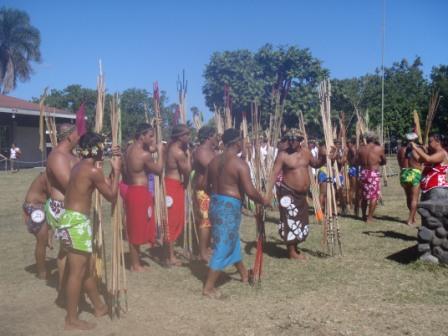 And here is a lady , taking it
seriously:
 And the result:
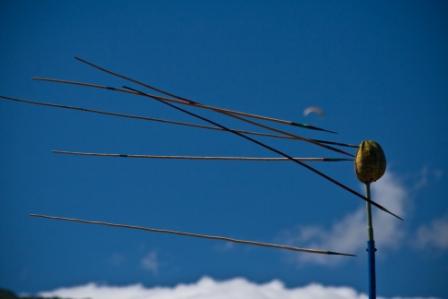 The javelins are made of local sticks, none of them
the remotest bit straight or true, tipped with a sharp metal blade. How it's
possible to hit the target I don't know. Men and women compete, to hit a coconut
high on a pole.Each heat consists of the entire group hurling about ten javelins
each so a couple of hundred are thrown, of which a handful strike the coconut.
There is a complex scoring mechanism depending upon where the coconut is struck.
I cannot imagine what the origin is (the Polynesians lacked metal, and the
utility of stabbing a coconut several metres in the air escapes me. Another
Victorian invention, I suspect. But fun.
And there was stone lifting:
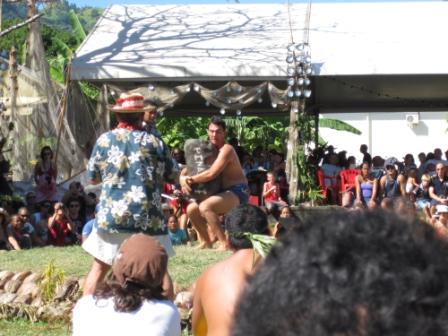 Here enormous men struggle to lift a huge stone
from the ground onto one shoulder for a second or so. The guy in the photo above
is halfway up; the man on the left in the flowery shirt and striped hat is one
of the judges.
And coconut tree climbing:
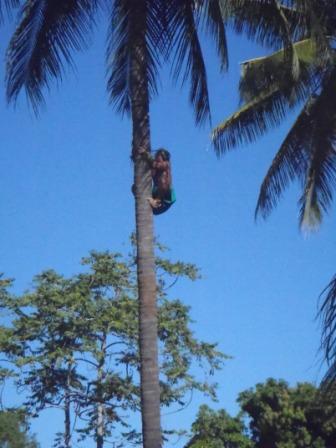 This was amazing. These guys can almost run up a
tree. The winner took less than five seconds to get his whole body above a
string tied round the trunk 10m off the ground. So fast that the
commentator (a vast Tahitian lady) who was so taken up by the event that she
missed this guy's start was heard by the entire audience to say "Mon Dieu" as
she turned round to discover that it was over.
And there's fruit carrying. this involves the men
carrying a 50kg load round a 1300m track. The women and youths carried less. The
fruit is tied to a log, and scrupulously weighed. the log is arried on the
shoulder where it rubs a raw wound. Here is the start of the men's
race:
 And a competitor:
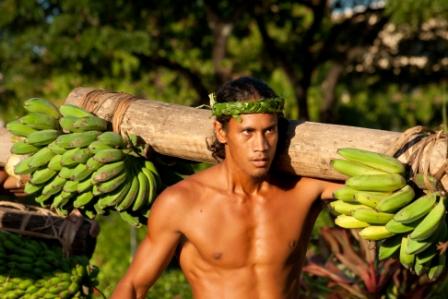 A good time was had by all. No drunkeness, no rowdy
behaviour, no litter and lots of friendly rivalry. We could learn from
this.
|